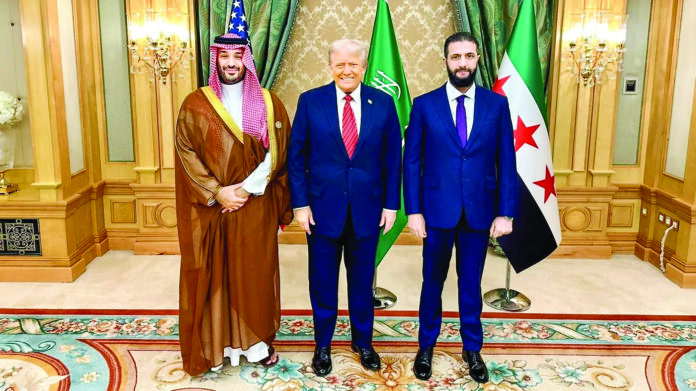
As America reimagines its legacy in West Asia, India is preparing to assume a complementary but distinct role as a facilitator of progress, reliability, and regional stewardship.
NEW DELHI: President Trump’s escalation in the Iran-Israel war began with an emphatic political and strategic endorsement of Israel’s pre-emptive aerial strikes on Iran on June 13 and culminated in a dramatic US strike on Iran’s nuclear facilities, steps that placed America squarely in the theatre of conflict. Yet, few informed reports suggest these strikes may have been scripted, with Iran tipped off in advance and coordinated within a broader de-escalation deal, keeping in mind a precarious ceasefire that was to be brokered soon after. In this arrangement, each side struck essential assets—America its largest regional base at Al Udeid in Qatar, and Iran its nuclear infrastructure—constituting a “performance of power,” a show rather than a definitive war.
This flurry of military posturing was followed almost immediately by ceasefire overtures. President Trump doubled down publicly on negotiation, raising important question, as to, did the United States simply run out of political and operational will midway through the conflict? Or was this a carefully scripted retreat, another strategic pivot away from deep Middle Eastern engagement, as the “America First” doctrine promised? At the heart of this dilemma lies a profound strategic tension. On the one hand, the US is determined not to be drawn into a protracted war beyond its borders, especially one that falters into a Russia-Ukraine-style grinding conflict with mounting casualties, billion-dollar expenditures, and creeping geopolitical entanglements. Its withdrawal from Afghanistan, retrenchments in Iraq, and diminishing commitments in Syria, though controversial, offer precedent. Second, Trump’s domestic Make America Great Again (MAGA) doctrine thrives on the idea of reducing overseas military entanglement and focusing on domestic priorities, so a prolonged Middle Eastern war could prove politically toxic. Third, the US needs time to validate intelligence on Iran’s relocated uranium stockpiles, another reason to cool the conflict temporarily. And fourth, no viable regime-replacement plan exists in Iran, stripping any forward momentum from the conflict. Collectively, these factors suggest that escalating beyond current levels would yield diminishing returns at greatest cost, politically, militarily, and financially.
Still, the United States remains deeply embedded across West Asia. It maintains somewhere between 40,000 and 60,000 troops across over 10 countries. Key installations include Al Udeid in Qatar with nearly 10,000 personnel, Al Asad in Iraq, the naval support base in Bahrain with around 9,000 troops, and others spread across Kuwait, the UAE, Oman, Syria, Jordan, Turkiye, and Saudi Arabia. Aircraft carriers and destroyers are also actively deployed in the region’s strategic waterways. Foreign military financing secures key allies like Israel, Egypt, and Jordan, amounting to over $5 billion annually. This expansive footprint spanning military personnel, permanent bases, naval flotillas, and security aid, reveals that Washington’s influence remains significant. Yet, the unstated strategy is undeniably shifting, that is, to pivot away from unilateral influence toward a posture of “broker-in-chief.” Under Trump and even Biden, peace initiatives such in the Abraham Accords, the triangular I2U2, and the India-Middle East-Europe Economic Corridor (IMEC) saw the United States positioned as sponsor, not principal actor. Post-ceasefire, this trend is becoming more pronounced.
The IMEC, launched in 2023, encapsulates America’s preference for networked diplomacy. Designed to connect India, Gulf states, Israel, and Europe, it is led operationally by the latter parties. Washington supplies diplomatic heft and supporting frameworks but refrains from shouldering core operational duties. Similar patterns are evident across MAGA-era engagements: partnerships are formed, leverage is extended, but the US intentionally recedes to let regional and allied actors assume responsibility, preserving influence but limiting exposure. Despite having largely ended American reliance on Gulf energy, retaining a commanding presence in the region remains a strategic imperative. The US withdrawal history shows that even after forceful drawdowns, vacuums were often filled by ISIS in Iraq, the Houthis in Yemen, and Iran-backed militias across Syria, leaving half-functioning states in their wake. The question now is whether the US can step back from frontline dominance without repeating past mistakes.
Reports of scaled-back aircraft presence at Al Udeid—dropping from around 40 fighter jets to fewer than 10 within weeks—show a deliberate reshaping of posture. The approach today seems less about robust containment and more about calculated flexibility. The US is less of a settler in the region and more of a short-term landlord of influence, willing to exert power, but unwilling to dwell in prolonged ownership. Yet Washington remains acutely aware of the geopolitical vacuum such a pivot may create. Russia and China are observing, ready to expand their influence predominantly via economic engagement rather than overt military deployment. Neither Moscow nor Beijing participated directly in the Iran-Israel clashes, but both have signalled readiness to capitalize on any void. Their approach relies on diplomacy, trade agreements, infrastructural financing, and security partnerships as tools that align better with the post-conflict preferences of many regional states.
This context clarifies America’s strategy, rather than retreat, it is evolving. The US is aligning with like-minded partners—India, Europe, Israel, UAE, Saudi Arabia—through frameworks like I2U2 and IMEC to erect economic and strategic fences around potential influence zones. Such collaboration helps mitigate the risks of unilateral withdrawal, slows the Kremlin and Beijing’s momentum, and transitions America from a deployed power to a convenor of regional resilience.
Yet a key blind spot in this repositioning strategy remains Iran itself. Given the embarrassment and humiliation inflicted upon Tehran both symbolically and strategically, it is likely to reenergise with more aggression and regional assertiveness. What remains unclear is how Washington intends to contain such resurgence. Does the US have a viable strategy to deal with a re-assertive Iran? Beyond containment and deterrence, regime change remains a longstanding but nebulous narrative with no clearly articulated endgame. Without a credible alternative leadership model or internal democratic transition plan, calls for regime change risk becoming rhetorical at best. Iran’s powerful regional proxies across Lebanon, Iraq, Syria, and Yemen remain intact, and its capacity for grey zone warfare is undiminished, if not emboldened.
Domestically, American public opinion and Congress remain divided over the extent and form of involvement in the Middle East. Various recent polls conducted by CNN, CBS News, The Washington Post, and Young Men Research Project found that approximately 45% of Americans oppose US airstrikes on Iran, with just 25% supporting them, and the rest undecided. Among Republicans, about 47% support the strikes, while nearly two-thirds of Democrats oppose them. Another survey placed total public opposition to military involvement in the region at around 60%, with only 16% in support. Even among President Trump’s own base, over half oppose deeper involvement in Middle Eastern wars. On Capitol Hill, the debate has sharpened. While some Republicans argue that the President, as Commander-in-Chief, acted within his constitutional mandate, a bipartisan cohort of legislators is mobilizing to reclaim congressional authority on military interventions, pushing for reforms to the War Powers Resolution and greater oversight of future use of force.
These domestic currents weigh heavily on Washington’s broader regional posture. American withdrawal from Iraq, Yemen, Syria, and Afghanistan—each framed as strategic retreats—have repeatedly precipitated power vacuums, insurgents or proxies filling gaps and governance faltering. The fear remains that a sudden pivot away from West Asia could invite new instability, even while Iran, Russia, and China look to exploit the gaps.
A fractured, half-resolved conflict in West Asia raises profound implications for India. As America coordinates its exit, China’s attempts to fill the void offer little strategic alignment for New Delhi. A deeper Sino-Russian footprint in West Asia carries risks of realpolitik agendas that may clash with India’s democratic values and strategic autonomy. Yet the US withdrawal also presents a rare leadership opening for India. Regional partners are already signalling their interest. Saudi Arabia’s Vision 2030 and the UAE’s Centennial 2071 have articulated growth-driven agendas that require reliable collaborators and actors that New Delhi can engage meaningfully, without seeking dominance. India’s diplomatic networks and diaspora communities—over 9.5 million strong and active across the Gulf—can be mobilized as bridges, fostering cultural anchoring and political dialogue. Indian caucuses in Gulf parliaments can bring local issues to the global stage, bolstering India’s reputation as a trustworthy and community-focused actor. These soft power bonds, when combined with India’s evolving defence cooperation—under maritime ties with the UAE, Abu Dhabi’s PKSF, and exercise partnerships like “Zayed Talwar” with the Indian Navy—can allow deeper strategic integration.
Economically, India’s expanding trade and energy diplomacy, anchored in LNG supply agreements, pharma exports, IT services, and infrastructure partnerships under I2U2 and IMEC, signal a region-centric but non-hegemonic posture. Unlike prior great-power scripts, India’s approach trusts in partnership, not projection. It offers capabilities and capacity, not conditionality. In doing so, it can position itself as a balanced stakeholder within emerging power networks. As America reimagines its legacy in West Asia—less as an occupier and more as a convenor—India is preparing to assume a complementary but distinct role as a facilitator of progress, reliability, and regional stewardship. In an increasingly fragmented landscape, India’s emerging presence may help stabilize the system. But doing so will require consistent, coordinated diplomatic, economic, and defence policy, delivered not as a surrogate for declining power but as a peer partner in shaping the region’s next chapter.
* Dr Manjari Singh focuses on contemporary Middle Eastern affairs and is the author of “India and the Gulf: A Security Perspective”. She is also a subject matter expert at Centre for Joint Warfare Studies.







